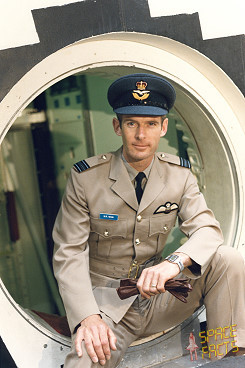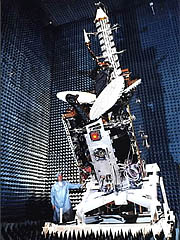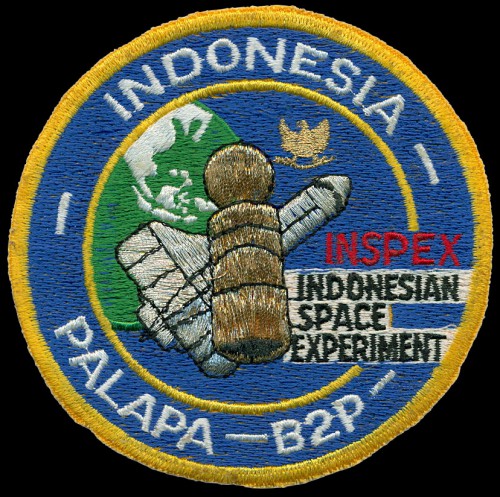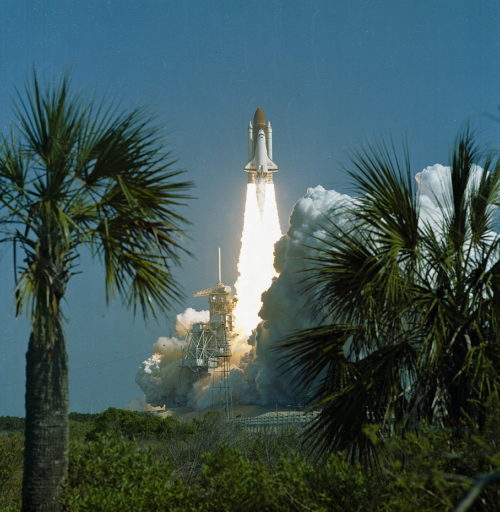
It has been almost a quarter of a century since Britain’s first astronaut, Helen Sharman, undertook an eight-day commercial flight to the Soviet Union’s Mir space station in May 1991. Yet for every successful human space venture, there are others which were unsuccessful or which never had the opportunity to bear fruit. Twenty-nine years ago, this coming week, in an alternate Universe, a distinctly English accent might have been heard crackling over the communications link between Shuttle Columbia and NASA’s Johnson Space Center (JSC) in Houston, Texas. Royal Air Force Squadron Leader Nigel Wood was deep into training as a payload specialist for Mission 61H at the time of the calamitous January 1986 loss of Challenger, and, had the hands of fate turned more kindly, he might have been the first British national to break the bonds of Earth and venture into space.
Planning for Wood’s flight had begun in January 1984, when the Ministry of Defence (MoD) revealed that it had contracted to launch its Skynet 4A and 4B communications satellites aboard the shuttle. However, in order to visibly demonstrate the British government’s support for its European partners, it reserved the right to fly a third satellite—Skynet 4C—atop an Ariane booster. “The £60 million or so that it will cost to fly two Skynet 4s on the shuttle is probably slightly cheaper than flying on Ariane,” Flight International told its readers, “and no doubt was a factor in selecting the American launcher.” The row between the MoD and the French-led Arianespace organization over the Skynet 4C contract continued throughout 1984 and 1985, right up until the very eve of the Challenger accident.
Rumors of shortlisted candidates from the RAF and the Royal Navy (RN) proved accurate when, in February 1984, four finalists were selected for shuttle payload specialist instruction. In addition to the RAF’s Wood, they included civilian physicist Christopher Holmes, who was then serving as the MoD’s deputy manager for Skynet 4, together with RN engineer Commander Peter Longhurst and British Army engineer Lieutenant-Colonel Tony Boyle of the Royal Signals. (Boyle was later replaced by fellow Signals officer Richard Farrimond in July 1984.) Nigel Wood was formally announced as the prime payload specialist for the Skynet 4A mission by UK Defence Secretary Michael Heseltine on 24 April 1985, with Farrimond as his backup. For the Skynet 4B mission, Longhurst would serve as the prime payload specialist, with Holmes as backup. In a 2010 interview, Wood explained that Heseltine had only told him that he was the prime candidate a mere 10 minutes before the press conference. Shortly afterward, the two men began 17 weeks of training alongside a five-member NASA crew, which had been announced some months earlier.

Originally designed “Mission 61C,” the names of Commander Mike Coats, Pilot John Blaha, and Mission Specialists Norm Thagard, Anna Fisher, and Bob Springer were released by NASA at the end of January 1985. The seven-day flight was scheduled for launch on 20 December, aboard the orbiter Columbia, and they were tasked with the deployment of two communications satellites—Westar VII for Western Union and Satcom Ku-2 for the Radio Corporation of America (RCA)—atop Payload Assist Module (PAM)-D boosters. Additionally, according to the NASA news release of the 61C crew announcement, the five astronauts would support the third Microgravity Science Laboratory (MSL-3) in Columbia’s payload bay and Thagard and Springer would execute at least one spacewalk to build the Experimental Assembly of Structures in EVA (EASE) and Assembly Concept for Construction of Erectable Space Structures (ACCESS) as part of early Space Station development work.
Interviewed years later as part of a NASA oral history, Blaha described being summoned to the office of George Abbey, director of Flight Crew Operations at JSC. “I hadn’t seen George Abbey for four or five years,” Blaha recalled. “I mean, I’d seen him, but we hadn’t had a conversation.” Abbey extended the usual pre-assignment pleasantries, then asked if Blaha wanted to fly as the pilot of Mission 61C. Not surprisingly, it was a question with only one answer, and Blaha began training for a mission whose character would morph significantly over the following months, as payloads and crew members were shifted. By April 1985, Coats’ mission had been redesignated “61H” and rescheduled for no earlier than June 1986; its crew was expanded to seven, with British and Indonesian payload specialists soon to be announced and its payload changed to include Britain’s Skynet 4A, Indonesia’s Palapa-B3 and McDonnell Douglas’ pallet-mounted Electrophoresis Operations in Space (EOS) facility. Crew positions changed, too. In September 1985, Thagard was removed from the crew and reassigned to the 61G Galileo-deployment mission, planned for May 1986, in order to replace astronaut John Fabian, who was about to retire from NASA. Thagard’s place on the 61H crew was taken by veteran astronaut Jim Buchli.
Unlike the post-Challenger shuttle manifest, in which payloads generally remained stable and astronauts remained “anchored” to their missions, this was not always the case in the mid-1980s. “Today, you get assigned to a flight and that’s the flight you’ll fly,” reflected astronaut Steve Hawley. “If the payload’s delayed, then you delay with the payload. Back in those days, a lot of the flights were similar: they were launching satellites or running some experiments that could be quickly learned and it wasn’t as important to stick with your payload.” By the time NASA published its final pre-Challenger shuttle manifest in November 1985, Coats’ 61H crew was scheduled to launch on 24 June 1986 with Skynet 4A and two other communications satellites: Palapa-B3, on behalf of the Indonesian government, and Western Union’s Westar VI-S. Columbia would enter an orbit of 190 nautical miles (350 km), inclined 28.5 degrees to the equator, for a seven-day flight.
With Nigel Wood assigned as the sixth member of the crew, his duties encompassed monitoring the deployment of the 2,750-pound (1,250 kg) Skynet 4A, which represented one of the most powerful communications satellites ever placed into orbit. Built by British Aerospace Dynamics, in partnership with Matra Marconi and Astrium, its cube-shaped “bus” housed four super-high-frequency transponders, two ultra-high-frequency transponders, and two C-band transponders. The satellite was capable of an operational lifetime of up to six years, powered by a pair of deployable solar array “wings,” which extended to 52.5 feet (16 meters) and provided 1,200 watts of electrical output when fully unfurled in a 22,300-mile (35,900 km) geostationary orbit. It also incorporated an experimental extremely-high-frequency (EHF) uplink channel, to be utilized by the Royal Signals Research Establishment, whose hardware was delivered to payload integrator Matra Space Systems for installation and testing in January 1985. “Providing a single 45 GHz uplink channel,” explained Flight International, “the equipment will be used to determine propagation conditions encountered at high frequencies.”

The size and mass of Skynet 4A required it to utilize McDonnell Douglas’ uprated Payload Assist Module (PAM)-D2 to boost it from the low-Earth orbit altitude of the shuttle to its final geostationary location. Most earlier shuttle-launched communications satellites had flown atop the PAM-D, which carried the potential to deliver payloads measuring up to 6.6 feet (2 meters) in diameter and weighing up to 2,750 pounds (1,250 kg) to geostationary altitude, placing Skynet 4A right at the upper margin of its capability. The PAM-D2 sported an upgraded Star 63D engine and could despatch larger payloads measuring up to 10 feet (3 meters) in diameter and weighing up to 4,140 pounds (1,880 kg) into geostationary orbit. This required a moderately larger “cradle” in the shuttle’s payload bay. The attractiveness of the PAM-D2 had already been noticed by the U.S. Air Force, which signed a $169 million contract with McDonnell Douglas in March 1985 to build 28 of the boosters to launch its network of Navstar satellites from the shuttle in 1987.
Unfortunately, Skynet 4A encountered numerous technical difficulties through the spring and summer of 1985. In June, it was reported that the satellite was six months behind schedule and Peter Conchie, head of business planning in British Aerospace’s Space and Communications Division, described it as “a very tight program to hold.” By this point, Skynet 4A’s structural hardware had been integrated at British Aerospace’s facility in Stevenage, Hertfordshire, and was awaiting shipment “to various European locations for testing,” preparatory to delivery to the Kennedy Space Center (KSC) in Florida. Three months later, in September, its communications payload—described as the most advanced of its kind ever built in Europe—was transported from Matra Space Systems to British Aerospace for integration and testing.
At around the same time, the 61H crew expanded to seven members with an addition of a second payload specialist. By this stage the cargo manifest had expanded to include Palapa-B3, and if a customer’s satellite or experiment consumed more than a certain amount of the payload bay, NASA offered an accompanying seat for one of their representatives. In September 1985, a team of four candidates were selected by the Indonesian government to accompany Palapa-B3 into orbit. They included Bambang Harimurti, a journalist with the Indonesian weekly news-politics magazine Tempo, Indonesian Air Force captain M. Jusuf, telecommunications engineer Taufik Akbar, and a female microbiologist named Pratiwi Sudarmono. These four were eventually winnowed down to two candidates, with Pratiwi assigned to become Indonesia’s first person in space and Akbar serving as her backup. This promised to make the East Asian archipelago the first sovereign nation in history to have a woman as its first astronaut. Alongside Britain’s Nigel Wood, she would also be the eighth foreign national to be assigned to fly aboard the shuttle, after West Germany, Canada, France, Saudi Arabia, Holland, and Mexico.
“I thought they were neat people,” John Blaha remembered of Wood and Pratiwi. “They were very, very talented people. I thought they brought a lot to the mission.” He also reflected that Wood was something of a kindred spirit, since both men were officers in their respective nations’ air forces, and Blaha had served as an RAF exchange pilot prior to his selection into NASA’s astronaut corps.

Little is known about Pratiwi’s experiments, with the exception of a giant Sumatran frog that would have been carried aboard Columbia as part of a life sciences investigation. Palapa-B3 would be the third satellite of its kind to be orbited by the shuttle, following on the heels of Palapa-B1 (launched in June 1983) and Palapa-B2 (launched in February 1984). Unfortunately, the latter—and another satellite, Westar-VI—failed to enter geostationary orbit, due to malfunctions with their PAM-D upper stages. Following negotiations between NASA, the prime contractor, Hughes, and the insurers, Lloyds of London, a daring “rescue” mission by the crew of STS-51A in November 1984 retrieved both satellites and brought them back to Earth for refurbishment and reuse. The expectation was that both would be launched a year or so later, but in February 1985 it was reported that Lloyds had been unsuccessful in securing a buyer.
In the meantime, Palapa’s operator, Perumtel, ordered a replacement satellite in the aftermath of the 41B failure. Designated Palapa-B3, it was based on Hughes’ cylindrical HS-376 satellite “bus,” measuring 9 feet (2.7 meters) long in its stowed configuration and 7 feet (2.1 meters) in diameter and weighing 1,520 pounds (690 kg) at launch. However, after the deployment of its 6-foot-diameter (1.8-meter) antenna and outer telescoping solar panel, the spin-stabilized Palapa-B3 would expand to a length of almost 23 feet (6.9 meters). Its body-covered solar cells produced 1,100 watts of electrical power to support 24 C-band transponders, which carried 1,000 two-way voice circuits or a single color television transmission to Indonesia, Papua New Guinea, and the entire land mass of the Association of East Asian Nations (ASEAN).
Assigned to Mission 61H, Palapa-B3 was somewhat lighter than Skynet 4A and thus was assigned to fly atop the slightly smaller PAM-D booster. The third communications satellite payload for Mike Coats’ mission was Westar VI-S, developed on behalf of Western Union, as a spare for Westar-VI. This satellite was originally co-manifested alongside the ASTRO-1 payload, aboard Mission 61E, but was subsequently moved to 61H. Like Palapa-B3, it was based on the cylindrical HS-376 “bus,” but weighed a little less at 1,280 pounds (580 kg) at launch. It carried 24 C-band transponders, each capable of accommodating 2,400 telephone calls or one television channel. Like Palapa-B3, it would also be delivered to geostationary orbit by means of the lighter PAM-D booster.
All three satellites for Mission 61H—Skynet 4A, Palapa-B3, and Westar VI-S—and their attached PAMs would have each been housed within a sunshade cradle, composed of machined aluminum frames and chrome-plated steel longeron and keel trunnion fittings and covered with Mylar insulation. Visibly, when the cradle’s doors were opened in orbit, their gaping “jaws” resembled the title character of the popular 1980s-era arcade game “Pacman.” Each cradle measured 8 feet (2.4 meters) in length and 15 feet (4.6 meters) across the span of the shuttle’s payload bay. At its base was a turntable with a pair of electrical motors which imparted a required spin rate upon the satellites and their PAMs. This spin rate could be set in the range of 45-100 revolutions per minute, dependent upon the stability needs of the payload, after which a spring ejection system would release them into space.

During Columbia’s ascent to orbit, the cradle doors would have been “open” and a pair of restraint arms would have held each of the three satellites in place. Shortly after entering space, and after opening the shuttle’s payload bay doors, the doors would have been closed, in order to protect the unpowered satellites from the thermal extremes of low-Earth orbit. They would then be reopened shortly before the deployment procedure. After being released from the payload bay, the spin-stabilization of the satellites would help to even out these thermal stresses. Each deployment would require the “core” of the 61H crew to complete, and after departing Columbia’s vicinity Coats and Blaha would have maneuvred their ship to a safe separation distance before each satellite fired its PAM.
Almost three decades since the event, little material exists to describe the precise sequence of events—or even the configuration of the satellites, fore-to-aft, in the payload bay—but it can be supposed that the “character” of Mission 61H would have been not dissimilar to several of the shuttle’s other triple-PAM deployment flights, such as Mission 51G in June 1985 and Mission 51I in August 1985. Past precedent suggests that the three deployments would likely have gotten underway on the first day of the mission and occurred at 24-hour intervals thereafter.
In addition to overseeing the Skynet 4A deployment for the British government, Nigel Wood had trained to perform a series of (originally) six national experiments in Columbia’s middeck. These were formally approved by NASA in June 1985 for carriage aboard the shuttle and focused upon the effects of cosmic radiation, changes in head-eye co-ordination, and adaptation to the microgravity environment, studies of liquid-solid adhesive bonding, the ability to estimate mass in weightlessness, motor skills—including postural control—and an ergonomics experiment. The first three of these investigations were military in nature, provided by the Royal Aircraft Establishment, the RAF’s Institute of Aviation Medicine and the Royal Armament Research and Development Establishment, whilst two others originated from the University of Stirling in Scotland. Lastly, the liquid-solid adhesive bonding experiment was provided by Kodak and was designed to explore the effect of “inertial wetting” in microgravity on the stability of liquid zones in the study of adhesion between solid and liquid surfaces.
However, on 18 January 1986, only days before the loss of Challenger, it was reported by Flight International that the inertial wetting experiment, developed by British chemist Dr. John Padday, had been dropped from Mission 61H. In addition to his positions as chair of the European Space Agency’s (ESA) committee on space bioprocessing and head of the microgravity committee at the British National Space Centre, Padday headed Kodak’s research and development efforts in surface tension, microgravity, and fluid physics, and it was noted that he had achieved “fantastically good results from just a series of parabolic flights.” This prompted the inertial wetting experiment to be canceled.
As his long-awaited space mission drew inexorably closer, Nigel Wood had his own “bucket list” of things he was looking forward to seeing from low-Earth orbit. One of them was getting a proper bird’s-eye view of his birthplace in the area of the North Yorkshire moors. When pressed about his duties by a British journalist, he quipped that he did not expect to be called upon to perform an EVA, “unless they throw me out!”
On the bitterly cold morning of 28 January 1986, everything changed for Mission 61H.
The second part of this article will appear tomorrow.
Want to keep up-to-date with all things space? Be sure to “Like” AmericaSpace on Facebook and follow us on Twitter: @AmericaSpace




Ben, thanks for another enlightening look back at a busy time in spaceflight history. Regarding John Padday, I have a clipping from the late 1970s iirc touting him as a likely payload specialist. Did you come across anything about thatin your resercv?
John,
Many thanks for your comment. I came across the reference to Padday purely by accident, in a Flight International article from 18 January 1986, which mentioned his role in the inertial wetting experiment. If you have any additional information about Padday or STS-61H, please do share.
Best wishes,
Ben
Ben, it’s a pleasure to see such a well-researched article of our activities of 30 years ago. One small point about deploying the Skynet 4 from the Shuttle; as I recall there was no need to manoeuvre the Shuttle after deployment. We would spin the satellite up to about 60rpm, release it by spring force and then simply wait about 45 minutes to achieve a safe distance from the Shuttle before firing the PAM motor. One interesting aspect of Skynet was that we would erect the S-band antenna in the Shuttle bay before deployment. The antenna then violated the payload bay profile (i.e. once the antenna was up, you couldn’t close the Shuttle doors), so we had an emergency plan to cut the antenna off if deployment failed. As I recall, Bob Springer would have done the emergency EVA.
Best wishes, Nigel
Nigel,
Many thanks for your comment and your insight into this remarkable mission and a remarkable payload.
Best wishes,
Ben
Excellent History lesson!! I collect space patches and that drew my attention, never saw that patch before.
Best to all of you!
shsparks_13@yahoo.com
Thank you, Ben. For highlighting Pratiwi and the Palapa satellite. As being Indonesian I feel proud of her. 🙂
P.S. M. Yusuf is my grandfather